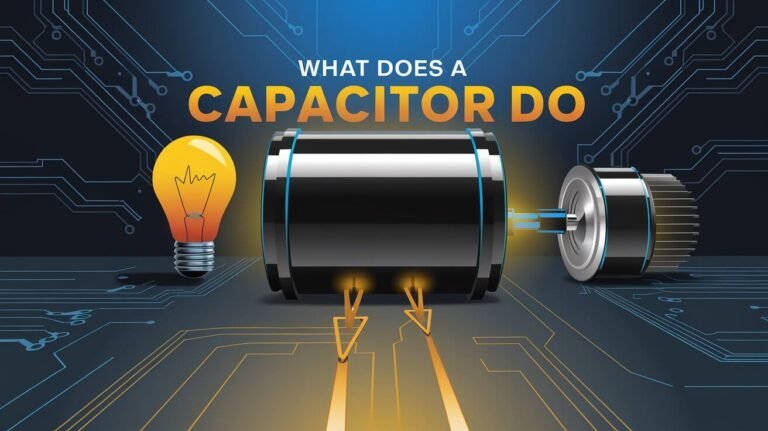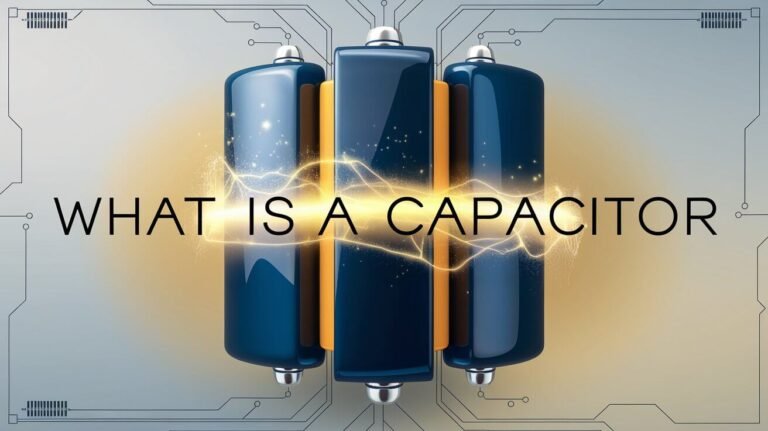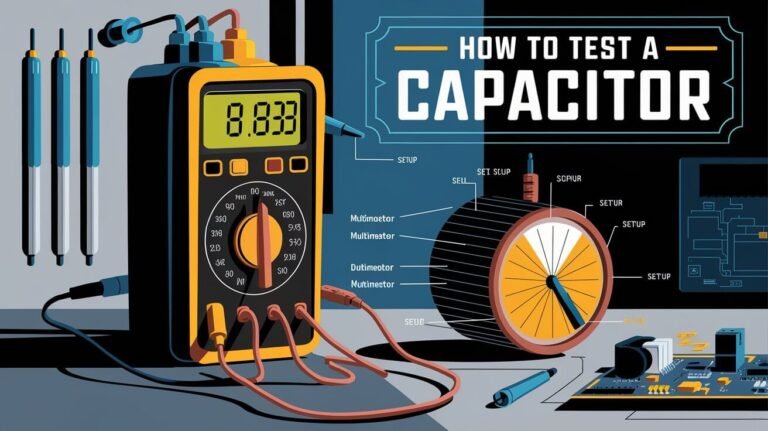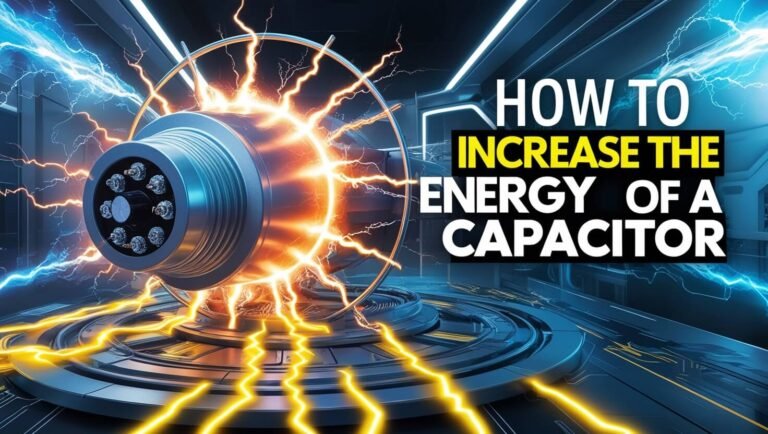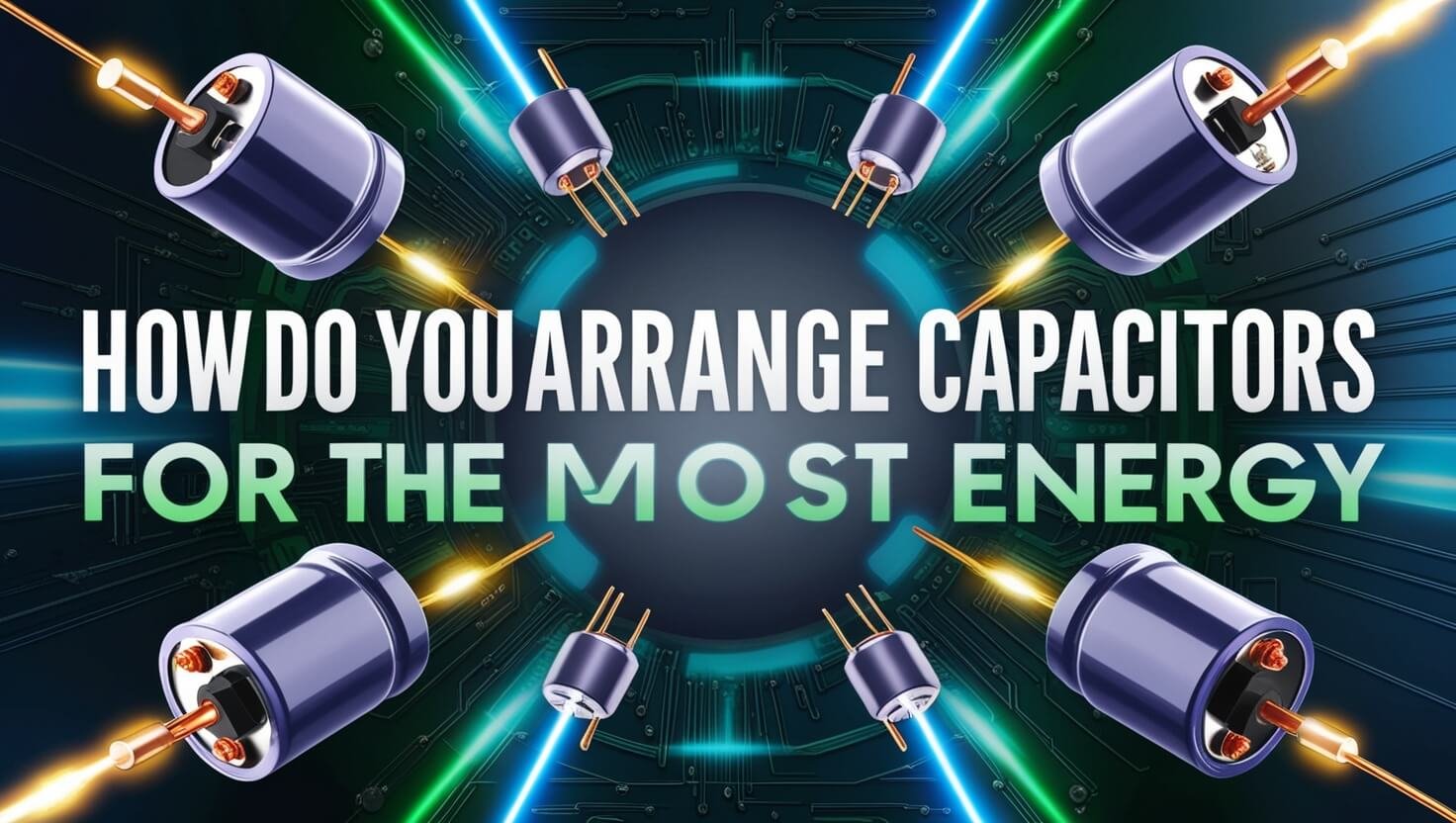
Maximizing energy storage depends a lot on how capacitors are arranged. Connecting them in series or parallel changes how much energy they can hold. Series connections mean less total capacitance and energy stored. But, parallel connections add up the capacitances, leading to more energy storage.
Knowing the best way to arrange capacitors is key. By connecting them in parallel, you get more capacitance and energy storage. This is because all capacitors share the same voltage, boosting energy density. Series connections are better for handling high voltages but aren’t as good for storing lots of energy. So, picking the right arrangement is vital for your needs, whether it’s for energy storage or other uses.
Basic Principles of Capacitor Energy Storage
Capacitors are key in storing energy. Knowing how they work is vital. The energy stored is given by U = 1/2CV^2, where C is capacitance and V is voltage. This shows how capacitance, charge, and voltage are connected.
Capacitors are used in many devices, like defibrillators and microelectronics. They supply energy. The charge stored can be found using Q = CV. For example, a 1.0-F capacitor holds 26.6μC when a 3.00×10^3V voltage is applied.
Capacitor Energy Storage Mechanics
The energy stored in a capacitor is given by E = 1/2CV^2. This shows that energy is directly related to capacitance and voltage squared. Different capacitors, with varying shapes and sizes, store different charges for the same voltage.
Voltage and Charge Relationships
The link between voltage and charge is key to understanding capacitors. The charge stored is directly proportional to the voltage applied, as shown by Q = CV. This is vital for designing and using capacitors in many fields, including defibrillators and microelectronics.
Energy Density Considerations
Energy density is a big deal in capacitor design. It depends on capacitance and voltage rating. High energy density capacitors are needed in small spaces, like in portable devices. Knowing how to design capacitors with high energy density is essential.
Types of Capacitor Arrangements
Capacitors can be connected in different ways to meet specific needs. These include series, parallel, and combinations. Each method changes the total capacitance and energy storage in a circuit.
In a series connection, the total capacitance is less. It’s found using the formula 1/Cs = 1/C1 + 1/C2 + 1/C3 + … . For example, 1.000 µF, 5.000 µF, and 8.000 µF capacitors in series give a total of 0.755 µF.
On the other hand, a parallel connection increases the total capacitance. The formula Cp = C1 + C2 + C3 + … is used. The same capacitors in parallel have a total of 14.000 µF.
Capacitor combinations can also be used to get specific values. For instance, mixing series and parallel connections can achieve a total of 8.833 µF.
When working with capacitors, consider a few things: * The type of connection: series, parallel, or a mix * The capacitance values of each capacitor * The desired total capacitance and energy storage * The voltage levels and dielectric constants of the capacitors
The table below shows the different capacitor arrangements and their characteristics:
| Arrangement | Formula | Example |
|---|---|---|
| Series Connection | 1/Cs = 1/C1 + 1/C2 + 1/C3 + … | 0.755 µF (1.000 µF, 5.000 µF, 8.000 µF) |
| Parallel Connection | Cp = C1 + C2 + C3 + … | 14.000 µF (1.000 µF, 5.000 µF, 8.000 µF) |
| Capacitor Combinations | Varies | 8.833 µF (mix of series and parallel) |
Parallel Configuration Benefits and Applications
Parallel capacitor connections have many benefits. One key advantage is the increase in total capacitance. This is found by adding up each capacitor’s value. The formula is Cp = C1 + C2 + C3 + …, where Cp is the total.
This increase in capacitance means better energy storage and filtering. It’s a big plus for many applications.
Parallel setups also distribute energy more evenly. This reduces stress on each capacitor. It makes the circuit more reliable and longer-lasting.
Also, parallel capacitors help regulate voltage better. This is important for keeping voltage stable in power systems.
Practical Implementation Methods
Parallel capacitors are used in many areas, like power supply filtering and energy storage. To use them well, you need to pick the right values and quality components. It’s also important to manage heat and space.
Energy Distribution Patterns
Improving energy distribution in parallel setups is possible. Techniques like parallel-series combinations and temperature compensation help. These methods make energy storage systems more efficient and reliable.
Such systems are key for renewable energy, car electronics, and industrial machines.
Total Capacitance in Parallel Circuits
To find total capacitance in parallel circuits, use the formula Cp = C1 + C2 + C3 + …. For instance, with two capacitors of 6 μF and 3 μF, the total is Cp = 6 μF + 3 μF = 9 μF. This is vital for knowing how much energy a parallel setup can store.
Series Configuration Analysis
In series capacitor circuits, the total capacitance is found by adding the reciprocals of each capacitor’s capacitance. This means adding more capacitors in series lowers the total capacitance. But, it increases the circuit’s voltage rating, making it safer for handling higher voltages.
When two equal capacitors are connected in series, their total capacitance is halved. For instance, two 6800pF capacitors together have a total capacitance of 3400pF. The capacitor with the smaller capacitance will have a larger voltage drop. The larger capacitor will handle more of the voltage because it has less capacitive reactance at the same frequency.
Important points in series capacitor analysis include: * Capacitance reduction: Adding more capacitors in series lowers the total capacitance. * Voltage division: The voltage drop across each capacitor depends on its capacitance and the total voltage. * Series capacitor analysis: Knowing the formula for total equivalent capacitance is key to understanding circuit behavior.
| Capacitor Configuration | Total Capacitance | Voltage Rating |
|---|---|---|
| Two 6800pF capacitors in series | 3400pF | Increased voltage rating |
| Multiple capacitors in series | Decreased total capacitance | Increased voltage rating |
Analyzing series capacitors is vital for circuit design and understanding circuit behavior. By looking at how series connections affect capacitance, voltage, and energy storage, engineers can make more efficient circuits.
How Do You Arrange Capacitors For The Most Energy Output
To get the most energy from capacitors, you need to think about the circuit design. How you arrange capacitors affects the energy output. When you connect capacitors in parallel, their total capacitance adds up, making it bigger.
But, if you connect them in series, the total capacitance is less. This is because you add the inverses of their capacitances. Knowing this helps you design a circuit that stores more energy.
Optimal Circuit Design Principles
For the best circuit design, keep these tips in mind:
- Parallel setups usually store more energy than series ones.
- The charge on parallel capacitors is split based on their capacitance.
- Series capacitors share the same charge, with the total voltage being the sum of their voltages.
Component Selection Criteria
When picking components, think about their capacitance and how it affects energy storage. Your goal is to find the best capacitor arrangement for your circuit.
| Capacitor Configuration | Total Capacitance | Energy Storage |
|---|---|---|
| Parallel | C = C1 + C2 | Greater energy storage |
| Series | 1/C = 1/C1 + 1/C2 | Lower energy storage |
Using these principles and thinking about your circuit, you can make a design that stores more energy.
Circuit Protection and Safety Measures
Working with capacitors requires careful attention to safety. Capacitors can hold a lot of energy. It’s important to handle them safely to avoid accidents.
To safely discharge a capacitor, follow certain steps. Use a resistor or a light bulb to slowly release the energy. The time it takes to discharge depends on the resistor and capacitor values.
Discharge Safety Protocols
Choosing the right resistor is key. Standard resistors can handle up to 0.25 W. But, bigger capacitors might need resistors that can handle 5 W to prevent damage.
Voltage Rating Considerations
It’s also important to think about voltage ratings. Using capacitors with the right voltage can prevent overvoltage issues. Make sure the capacitor’s voltage rating fits your needs.
Emergency Shutdown Procedures
Having a plan for emergencies is essential. In case of a problem, turn off the power and use a safe discharge method. These steps help keep you and your equipment safe.
| Capacitor Type | Voltage Rating | Discharge Method |
|---|---|---|
| Ceramic Capacitor | Up to 100V | Resistor or Light Bulb |
| Film Capacitor | Up to 400V | Resistor or Discharge Resistor |
| Electrolytic Capacitor | Up to 500V | Discharge Resistor or Specialized Discharge Circuit |
Real-World Applications and Case Studies
Capacitors are used in many ways, from small gadgets to big energy systems. They are key in power electronics for filtering, regulating, and storing energy. For example, they help power supplies by removing unwanted frequencies and keeping the voltage steady.
In energy storage, capacitors hold extra energy from sources like solar or wind. This energy is then used when needed, making power stable and reliable. Companies like Tesla and General Electric use capacitor systems to power homes and businesses.
Here are some examples of capacitor uses:
- Power factor correction in industrial power systems
- Energy storage in electric vehicles
- Filtering in audio equipment
The table below shows common capacitor applications and their energy storage systems:
| Application | Energy Storage System |
|---|---|
| Power factor correction | Capacitor banks |
| Electric vehicles | Supercapacitors |
| Audio equipment | Filter capacitors |
Troubleshooting Common Issues
Even the best capacitor setups can face problems like uneven voltage and heat. It’s key to find and fix these issues. Performance problems can come from wrong capacitor setups, making things less efficient and hotter.
Understanding why these problems happen is the first step. Voltage issues might stem from mismatched capacitance or wrong wiring. To fix these, use cooling systems and thermal interfaces. This way, you can keep your capacitor setup running smoothly and avoid damage.
Voltage Distribution Problems
Voltage imbalances can make things less efficient and hotter. To fix this, make sure all capacitance values are the same and wiring is right. Adding voltage regulators can also help keep the voltage steady.
Heat Management Solutions
Heat can be managed with cooling systems like heat sinks or fans. Thermal interfaces, like tape or grease, help too. These solutions can prevent overheating and keep your capacitor setup running well.
Performance Optimization Tips
To get the most out of your capacitor setup, match components well and wire correctly. Regular checks, like cleaning and inspecting, can also help. By following these steps and using good capacitor troubleshooting and heat management, your setup will work reliably.
Bottom Line
The way capacitors are arranged is key to storing and using energy well. By knowing how to arrange capacitors, engineers can make circuits better. This helps in storing more energy and getting ready for new capacitor tech.
When connecting capacitors, it’s important to pay close attention. You might connect them in parallel to boost capacitance or in series for voltage control. Always follow safety rules, like discharging them properly and checking voltage ratings. This ensures your projects work well and you can fix any problems easily.
Capacitor tech is always getting better, with new designs and materials. Keeping up with these changes helps professionals use capacitors more effectively. This way, they can make the most of these important parts in electronics.
Common Queries
What are the fundamental principles governing capacitor energy storage?
Capacitors store energy by building up electric charge. This happens through the link between voltage and charge. It also involves looking at energy density.
What are the different types of capacitor arrangements?
Capacitors can be set up in series, parallel, or more complex ways. Each setup changes the total capacitance and how much energy it can store.
What are the benefits of parallel capacitor configurations?
Parallel setups increase the total capacitance. They also help distribute energy well and are easy to use for storing more energy.
How do series capacitor configurations affect energy storage?
Series connections lower the total capacitance. But, they help spread out the voltage, which can be good in some cases.
What are the key principles for arranging capacitors to maximize energy output?
For the best energy output, you need a good circuit design. Choosing the right components and checking their performance is also key.
What safety measures should be considered when working with high-energy capacitor arrangements?
It’s important to follow safe discharge methods. Stick to the voltage limits and have a plan for emergencies to keep systems safe.
What real-world applications benefit from optimized capacitor arrangements?
Optimizing capacitors can make systems more efficient. This is true in fields like power electronics, renewable energy, and industrial automation.
How can common issues in capacitor arrangements be addressed?
To fix problems, use troubleshooting methods. This includes solving voltage issues and managing heat. These steps can improve capacitor performance.

